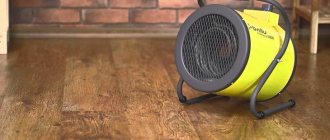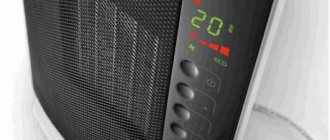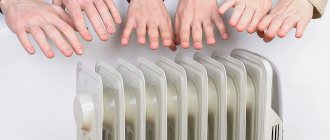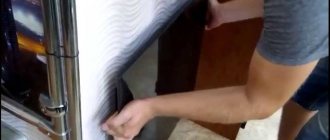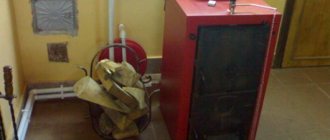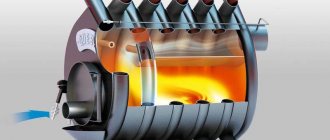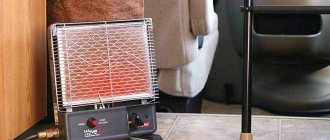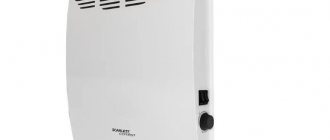Automatic temperature control in living and working spaces is a modern and effective means of saving energy resources and saving money on heating. The use of heaters and thermostats for them is especially important for owners of private houses in winter, because maintaining a certain temperature in the room is always more profitable than warming up the room when the temperature is below zero. We talk about the best models of thermostats for heaters, as well as how to choose them.
Features and types of thermostats
Rod thermostat for boiler
The thermostat performs 3 functions:
- turns off water heating when the liquid temperature reaches the desired level;
- when the water temperature drops below the specified value, the thermostat turns on the heating elements;
- When the boiler overheats, the thermostat turns off the device to prevent its breakdown.
The principle of operation is simple: the device closes the contacts when the water cools and opens when it is sufficiently heated. The thermostat is equipped with a signal indicator. When the device is working, the indicator lights up, when it turns off, it goes out.
There are 3 main types of regulators.
Rod
The simplest and most affordable option. This is a tube made of a material capable of linear expansion. As the temperature rises, it increases in size, puts pressure on the contacts and opens them. When the water cools, the rod shortens and closes the contacts. Depending on the set temperature, the thermostat is located closer or further to the connection point.
The disadvantage of the rod model is its inaccuracy. The device is installed near the cold water supply system, so it is cooled to a greater extent than the heated liquid. As a result, the water is heated to a higher temperature than specified.
Capillary
It consists of a tube made of anti-corrosion materials and a capsule inside filled with a contrast liquid. When water heats up, it expands and puts pressure on the membrane. The membrane opens the contacts. When cooled, the liquid decreases in volume and closes the contacts.
A capillary thermostat is more accurate because liquids are cooled and heated at the same time and equally.
Electronic
The electronic temperature sensor for the boiler is the most accurate. The water is heated to the specified temperature. Thanks to its own protection, the device lasts longer. There are adjustment and protective options. The latter is connected to the protective relay. The device turns off the device if there is no water in the tank.
Bimetallic
The measurement indicator here is not the liquid in the capsule, but plates made of two different metals. When heated and cooled, metal plates expand differently and change their location. At the same time, they close or open the contacts of the heating elements. The advantage of the device is greater reliability and simplicity. This type of thermostat can be repaired, since its main failure is a loose circuit.
Electronic
Bimetallic
Capillary
Conclusions and useful video on the topic
Types of thermostats and their comparison:
By choosing the optimal thermostat model and correctly installing it in the outlet, you can make your life much more comfortable.
Now, in order to maintain the desired temperature in your home/office, you don’t have to constantly pay attention to the heater, turning it on and off. The thermostat itself will control this process, taking into account the settings set by the user, which will help to save energy.
Are you looking for a practical and convenient plug-in thermostat? Or do you have experience using such devices? Please leave comments on the article and share your impressions about using thermostats for heaters.
How to choose a thermostat
When purchased, the boiler is equipped with a control device. But when it fails, the owner has to purchase a new one.
The thermostat for the boiler is selected taking into account the following parameters:
- The model must match the dimensions of the water heater, the dimensions of the tubular electric heater and its power. To be on the safe side, it is better to take the technical data sheet of the product with you in order to find out all the parameters on the spot.
- Do not throw away the relay along with a deteriorated device. It will also help in choosing the right thermostat.
- It is necessary to take into account the dimensions of the device itself, the permissible current, resistance and other characteristics.
An electronic thermostat ensures water heating and reduces current consumption.
Replacement and connection
Location of the thermostat in the water heater
Failure of the thermostat is a common problem. Diagnostics is not difficult; the boiler owner can perform it. How to ring the thermostat on a water heater is described in the instructions.
- The device is removed from the boiler and switched to resistance measurement mode.
- The maximum permissible temperature is indicated and the resistance at the contacts is measured. If the thermostat does not respond, it has become unusable. It cannot be repaired, it must be replaced.
- If the thermostat responds, set the minimum temperature and measure the resistance again with the tester. Then use a lighter to warm up the body of the device.
- If the thermostat is working properly, it should open its contacts when heating. In this case, the resistance at the input and output should increase. If the water continues to heat up, the device needs to be replaced.
To test the thermostat, use a multimeter.
It is much easier to install a thermostat for any boiler than a pump or heat exchanger. It is best to buy the same model, but if the brand of the device is rare or this model is outdated, you can find another option that matches the parameters.
- Disconnect the device from the power supply, turn off the water supply and drain the water.
- Remove the lower part of the boiler, thereby gaining access to the heating elements. Remove the pressure ring of the heating element.
- The temperature sensors and control module are removed. Remove the thermostat and install a new one in its place.
- Return and fix the pressure ring and replace the bottom panel.
- Check the operation of the device by filling the boiler with water and setting the minimum temperature. If, after heating to the specified value, the device turns off, everything is in order.
The markings of a broken thermostat make it easier to find a new one. Do not immediately throw away the boiler parts.
How to do DIY repairs
If possible, the element can be repaired or a new one installed.
How to remove the thermostat:
- Disconnect the equipment from the network.
- Turn off the water supply.
- Drain the contents of the tank. You can use a special valve for this. Why you need a safety valve, read in a separate article.
- Dismantle the heating element. To do this, unscrew the nuts and bolts of the flange and remove it from the housing.
- The thermostat is usually located at or near the base of the heater.
- Disconnect the wiring and remove the sensor from the base.
In the case of a mechanical model, you can clean the bimetallic plates from oxidation . To do this, soak a piece of cloth in alcohol and wipe the plates. If the oxidation has spread greatly, then clean it with fine sandpaper.
You need to do this carefully so as not to touch the sensor contacts.
Due to power surges, the break contact could become stuck. To adjust, carefully remove it from the body and clean the problem area. Normally, the contact should fit into the socket automatically.
How to repair a contact if it does not work:
- Remove the part completely from the housing.
- Clean its surface, as well as the seat.
- If the contact does not turn on after cleaning, place insulating tape underneath.
- Reinstall the stem.
- Assemble the body.
Do-it-yourself troubleshooting
Scale in the boiler can cause the thermostat to break down.
A water heater is a fairly simple device. Some faults in it can be eliminated, and you can also perform diagnostics yourself. If an electronic or programmable control unit is installed, the latter will also notify the owner of the nature of the failure.
Signs of trouble:
- the water does not heat up - the thermostat, the temperature sensor, or the heating element may be to blame;
- heating data that does not correspond to the truth appears on the display;
- the boiler heats the water, but does not turn off when the liquid temperature reaches the specified value; the device overheats, you can only turn it off manually by disconnecting it from the power supply;
- on mechanical boilers the indicator indicating the functionality of the thermostat does not light up.
How to check the operation of the thermostat on a water heater is indicated in the instructions. The causes of the problems are as follows:
- wear of the copper tube in the thermostat - it is easier to buy a new device than to restore the old one;
- loose connection of the three-contact thermostat and heating element - the position of the contacts can be adjusted;
- failure of the control unit - the element must be replaced;
- the appearance of scale on the heating elements, due to which the contact between the heater and the thermostat is broken - just clean the heating elements;
- The device has failed due to a power surge - it cannot be repaired.
You can do the replacement yourself. However, if the boiler is under warranty, you need to contact a service workshop.
Editor's Choice
"Teplolux" BiZone
The device controls heated floors, convectors, fan coils, and heat curtains based on data from two remote floor temperature sensors in two control zones and one air temperature sensor in the device body. Sensor type TST02-2.0 or third-party sensors with resistance 10 kOhm, 12 kOhm, 15 kOhm, 33 kOhm, 47 kOhm.
"Teplolux" BiZone. Photo: Teplolux
Key features of the BiZone thermostat:
- Setting a schedule for turning on and off;
- Timer operation;
- Creating scenarios for a smart home in the Tuya Smart application;
- Control of rotation speed of fans of fan coils, thermal curtains and convectors;
- Information about energy consumption is provided in graphical form.
Thermostat operating modes are indicated by colored LEDs. To connect the device to a cloud service or smart home system, you need to scan the QR code in the device passport or on the manufacturer’s official website with your smartphone.
Specifications
| Operating temperature range | from 5°С to 45°С |
| Supply voltage | 230 V |
| Maximum power | 3.6 kW x 2 |
| Maximum control circuit current with active load | 5 A |
| Maximum control current with inductive load | IP44 |
Advantages and disadvantages
Compatible with a large number of controlled climate control devices
Not detected
Editor's Choice
Teplolux BiZone
Dual zone thermostat
Independent control of two zones remotely via WiFi via the TUYA application, integration into the smart home system and IP44 moisture protection class.
OrderDelivery terms
Range of thermostats for boilers
Thermostats differ from each other in size, shape, and design. However, among the manufacturers of these devices, the best can be distinguished. These are high-quality, durable and reliable products:
- Devi is a company from Denmark that has been operating on the heating element market since 1942. At first, the company produced devices for industrial needs. But already in the 60s the range was expanded. It now supplies both domestic and industrial heaters and thermostats.
- Mondail Electronics Co is a Chinese manufacturer offering household and electrical appliances and products for light industry. The range also includes thermostats for different types of boilers. According to reviews, the products are quite reliable and resistant to stress.
- RTCEelectronics is a South Korean company. Specializes in various types of household electrical appliances. A special feature of the product is adaptation to unstable operation of the electrical network, power surges, and poor-quality water. The company's thermostats are very popular in the Russian market due to their resistance to adverse operating conditions.
- Techem is a Swedish company. The main offer is automated metering devices for heat, gas, water and devices for regulating parameters. The products are high quality, but expensive.
- Valtec is an international organization that produces engineered plumbing and electrical appliances for household use. The products are adapted to Russian conditions. This is a very common brand in Russia.
A water heater cannot operate without a thermostat; this is a mandatory element of the device. Mechanical models are often equipped with a simple rod device. More modern boilers are equipped with electronic devices that can accurately regulate the temperature of the liquid.

